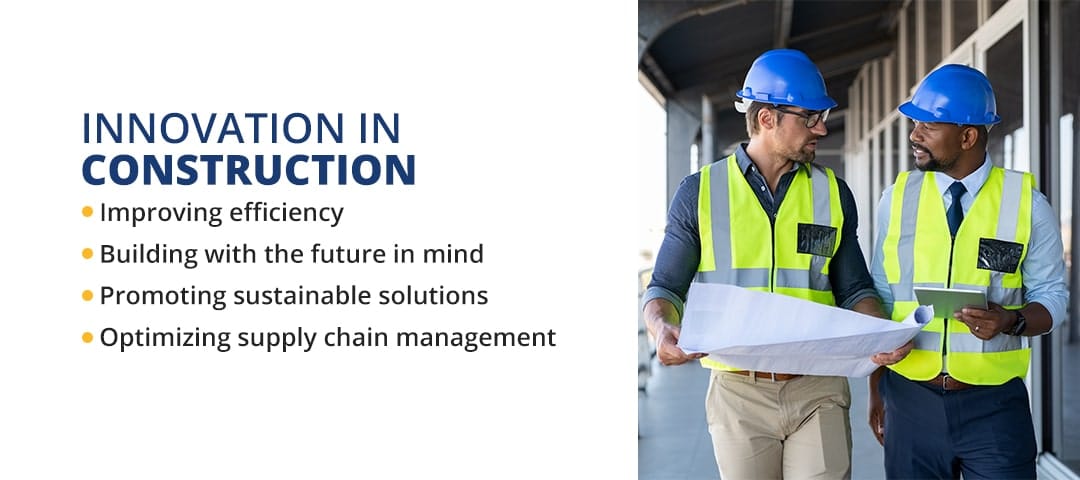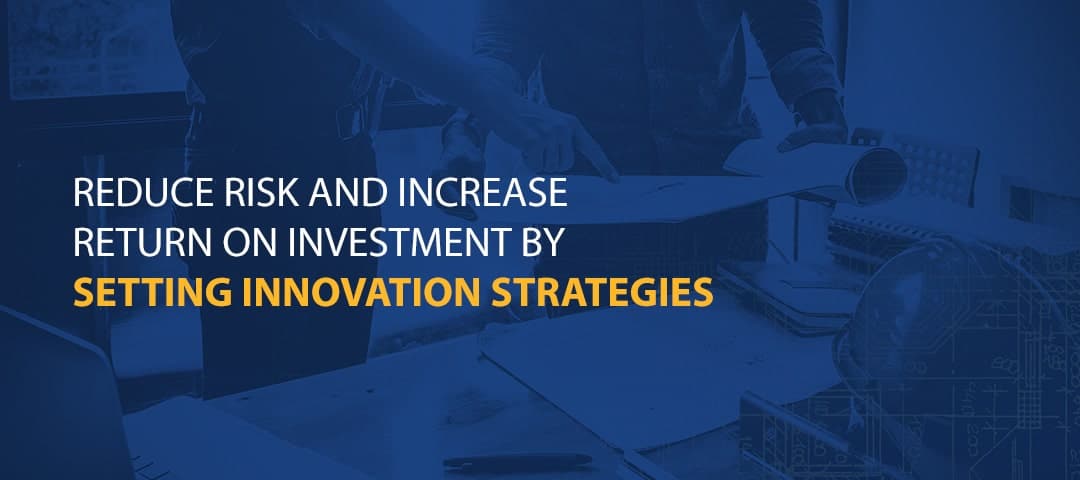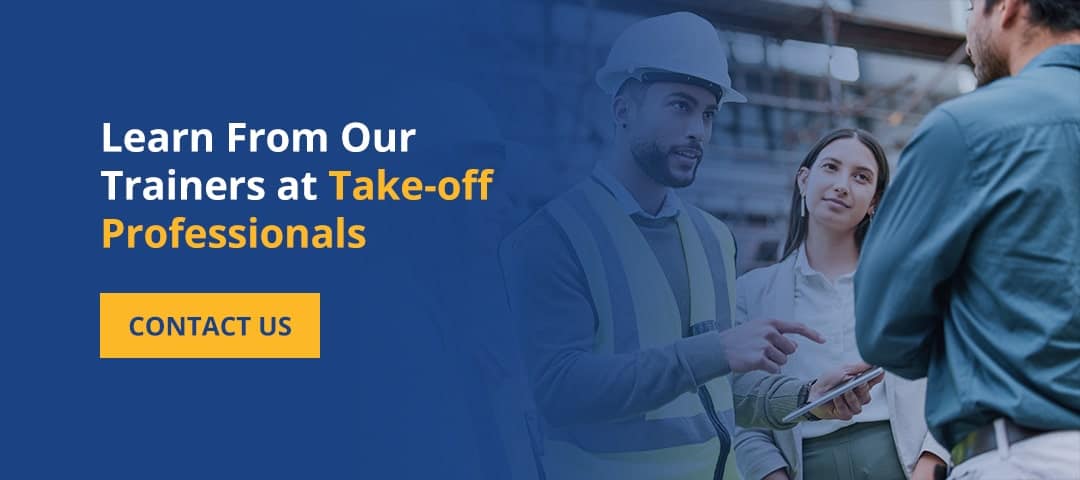Innovation strategies can mean progress in any industry but especially in the construction industry. Innovation can mean you deliver greater value to customers and work more efficiently. However, because of tight profit margins and risk, innovation or change isn’t always welcome. The right innovation strategies can help you reduce risk and increase your and your customers’ return on investment (ROI).
For any innovation strategy, you must make some changes. These changes could include everything from new methods of handling project planning, labor productivity, safety issues, document management and information sharing to budgeting and addressing overruns in scheduling or costs. At TOPS, we want to help you reduce risk and increase your ROI.

Innovation in Construction
Innovation is change and an openness to improving services, processes and products. Innovation is key to solving challenges you face at your work sites. In the construction industry, heavy equipment, complex materials and big machinery provide more ways to get the job done than ever. However, innovation has been a bit slow in construction compared to other sectors because innovation is expensive, lacks standardization and requires significant research. Shortages in labor and material availability can also hinder innovation. In this industry, you can foster innovation by:
- Improving efficiency: Improve the efficiency, productivity and quality of your work in the construction industry with a monitored and connected job site.
- Building with the future in mind: To build with the future in mind, use smart technology, new energy sources, better resource and asset management and innovative construction materials and methods.
- Promoting sustainable solutions: Many in the construction industry are innovating to promote sustainable solutions that can reduce their environmental impact.
- Optimizing supply chain management: Optimizing your supply chain management can make it easier to track fleets, improve inventory management and obtain services and materials.
Measuring Return on Investment
You can measure your ROI both internally and externally. Internal ROI includes process, profit and people.
- Process: This factor focuses on efficiency.
- Profit: This factor concentrates on the impact on your bottom line.
- People: This factor refers to employee engagement and skill level.
External ROI, on the other hand, includes competitiveness, community and customers.
- Competitiveness: This factor refers to how you show your competitive edge to win better projects.
- Community: This factor looks at how you manage and organize the subcontractors and supply chain within your professional community.
- Customers: This factor assesses how you acquire, keep and encourage repeat customers.
In measuring ROI, many hard metrics depend on cost and time savings. Some softer metrics are helpful to evaluate in times of high demand, fewer materials, sustainability and fewer people. For example, if you want to replace a manual task with software, you must first analyze whether doing so would save money and time and ensure accuracy. Workers should also feel positive about working with the software, and the software should improve performance and make the job easier to perform.
Increasing Return for Earthworks
To increase your ROI for earthworks, you should understand how to ensure a successful earthwork takeoff. Earthwork is the engineering process in which soil, rock and similar materials are removed, moved or added to change a location’s topography. To increase your return for earthworks, you may want to invest in earthwork estimating software. Some of the features of this software include trench profiling, grid views and strata layer breakdowns.
Introducing New Technology
Technology is the cornerstone of the construction sector’s innovation. From the latest technologies that facilitate sustainability to digitalized solutions that promote productivity, technology is essential to the industry. The goal is to identify new technology and tackle the challenges you have been facing.
To introduce new technology into your work, you need to take a strategic approach. To determine the right technology for a project, identify who will be impacted, lay out the process and choose the technology that improves the process.
- Identify employees: Determine who will be using this new technology or who will be impacted by it. Consider the current level of understanding and the level of understanding and awareness you need employees to have. With your team, communicate both the how and the why of this new technology.
- Lay out the process: Next, lay out the process for which you want to use this new technology. The technology should improve this process or help you determine whether you should implement a new approach.
- Choose the technology: Finally, select the right technology to improve your work. If you are unsure how to make this selection yourself, turn to the Take-off Professionals for help.
New technologies can make job site workers safer and overcome mobility restrictions with technology that aids in the delivery of materials. Today, artificial intelligence (AI) and robots allow construction professionals to work remotely without pausing their projects or exposing themselves to illness during a pandemic, for example. New technology can open the door to other innovative solutions in the construction industry.
Civil contractors use many machines, such as dozers, soil compactors, pavers, asphalt compactors, skid steers and machine control motograders. If you’re a civil contractor, you may also utilize full-scale aircraft or drones to capture data with photogrammetry. If you don’t already use this technology, these may be new tools you want to implement.
If you’re a surveyor, point cloud modeling is one example of new technology you may want to use to conduct land surveys more efficiently and easily. Point cloud modeling uses fewer resources while still accomplishing the same work. Point clouds are collections of several small data points that each represent part of a surface in a specific area like an engineering work site. Together, these points form a 3D structure. At TOPS, we use point cloud data as part of our 3D earthwork modeling.
Learn From Our Trainers at Take-off Professionals
As the experts in all things data, TOPS creates 3D data models for machine layout and control, including 3D utility layout, grading surfaces and utility trenches for machines, rovers, pavers and curb machines. We provide earthwork takeoffs with mass haul analysis for roads and sites, material and dirt quantities. Additionally, for the project’s life cycle, we create haul roads. To help boost your productivity on a construction site, we offer the following services:
- Quantity takeoffs
- Point cloud modeling
- Aerial lidar services
- 3D and GPS control modeling
To build the best 3D models, our team is composed of only full-time employees. Our focus is entirely on data preparation and modeling, so you can rely on our expertise. If you are a busy contractor in need of support with takeoffs and the right technology, we can help. Contact us at TOPS to learn more about reducing risk with construction innovation strategies.


